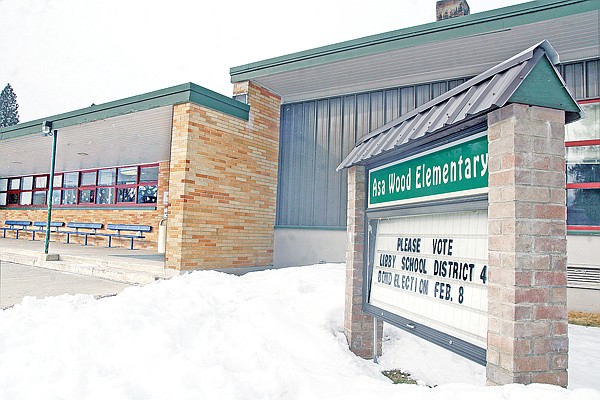Asa Wood to close this summer
Parents voiced apprehension. School
principals balked.
Libby superintendant Kirby Maki
guaranteed that it could be done, and some pointed out that it only
made fiscal sense.
In response to the district’s dire
financial situation, the school board on Monday voted, 5-2, to
expedite the consolidation of the student body into two campuses by
closing the district’s last remaining elementary building this
summer.
The board also looked over extensive
budget cut proposals – generated by Maki and building
administrators – that will be considered in the coming months once
the district gets a better picture of the funding available for
next school year.
The utility savings – fuel oil,
electricity and garbage collection – of operating one less building
will add up to about $200,000, Maki estimated. It will help close a
shortfall projected to be $450,000 at best, but Maki said the
number could realistically turn out to be double in size.
The board last September approved the
eventual closure of Asa Wood Elementary as a solution to an aging
building and the district’s shrinking enrollment and subsequently
smaller budget. The board had, however, originally discussed
keeping the building open for the 2011-12 year in order to allow
more time to plan for the move – seventh and eighth grades into the
high school and kindergarten through third grade into the middle
school.
Allowing a year for construction is no
longer essential, some members of the board argued, because voters
rejected a $12 million bond and, consequently, there is little
money to make renovations or additions. Moreover, they said,
teaching positions could be saved by closing the building.
Principals requested that the board
wait a year. Parents asked for assurance that their children would
not just be “stuffed in a classroom,” but that the consolidation
would be well thought-out.
“I’m asking you, realistically, can you
get those things in place that our children need?” one parent asked
Maki, who responded confidently.
Little construction work will be
carried out for the consolidation, trustee Lee Disney said, and
other plans – such as pickup and dropoff areas and which classrooms
go where – have been discussed for months.
“This is not just a whim,” he said.
“These things have been talked about in not just the last planning
process.”
The only construction, Disney said,
that will be performed inside the middle school, for example, is
renovating one set of bathrooms to accommodate small children.
Dissenting voters Bruce Sickler and
Paula Darko-Hensler, however, believed more time would benefit both
the children and staff.
“I just don’t think it’s appropriate,”
Darko-Hensler said. “I hear reservations and I hear they
(principals and teachers) are afraid of failing and not doing the
job they are capable of doing because they don’t have enough
time.”
The district eliminated the equivalent
of 10 full-time teaching positions last year to save $400,000, but
was only a little more than halfway to closing the 2010-11 budget
gap. Maki and the board avoided deeper cuts by spending about
$350,000 in one-time stimulus funding.
“That money was plugged in to maintain
teachers’ jobs and that money isn’t there anymore,” Maki said.
In the best-case scenario the state and
federal government will provide the same funding as the 2010-11
year. The shortfall would add up to roughly $450,000, which is last
year’s deficit plus the cost of “steps and lanes” – automatic
raises teachers receive for accruing additional experience and
education.
However, enrollment has shrunk again
and the district should probably expect the state to chip in
$150,000-$160,000 less, Maki said.
“If it turns out that it (the
shortfall) is only $450,000, we can take a sigh of relief to a
certain extent,” he said.
Another budget hit – the district will
most-likely absorb a projected $80,000-$85,000 in rising insurance
rates for teachers.
On top of that, Maki said at the
meeting, U.S. legislators have discussed cutting federal Title I
monies by 7 percent. Title I supplements schools in
economically-depressed communities to ensure equal access to
education.
“Many of our salaries are in Title I,”
he said. “It would be a devastating factor for us.”
Cutbacks have become a part of life at
Libby schools over the past few decades, but as the district gets
smaller, the reductions have become more serious.
Maki presented proposals at Monday’s
meeting that could potentially shave $818,400 off of the $7.9
million budget.
They are only considerations, Maki
warned, and hopefully some positions and programs will be saved
from the chopping block.
“Depending on what the shortfall turns
out to be, hopefully they’ll not cut as much as I anticipated,” he
said. “Then we can pick and choose what we’re going to keep and
what we will sacrifice.”
The board began the job of cutting the
deficit on Monday when it awarded administrator contracts and made
plans to close Asa Wood this summer.
The contracts for principals and vice
principals at the middle and high schools were renewed for another
year, while elementary principal Scott Beagle was offered a
teaching position. The special services supervisor’s contract –
worth $102,000 in salary and benefits – was not renewed.
Maki and curriculum director Jael
Prezeau plan to take on Kari Lewinsohn’s responsibilities, which
include coordinating the district’s special education program and
providing opportunities for gifted and talented students.
Additional full-time positions on the
list of possible cuts included three teachers, activities director,
three paraprofessionals, a secretary, a maintenance person and a
custodial aide, as well as a part-time library paraprofessional and
a part-time secretary. Other potential cuts affected activities,
maintenance, technology and more.
The district will be able to absorb
positions without laying people off if staff can be shuffled into
the right vacancies, Maki said. So far, two longtime teachers have
announced their retirement and a few paraprofessionals have
resigned.

